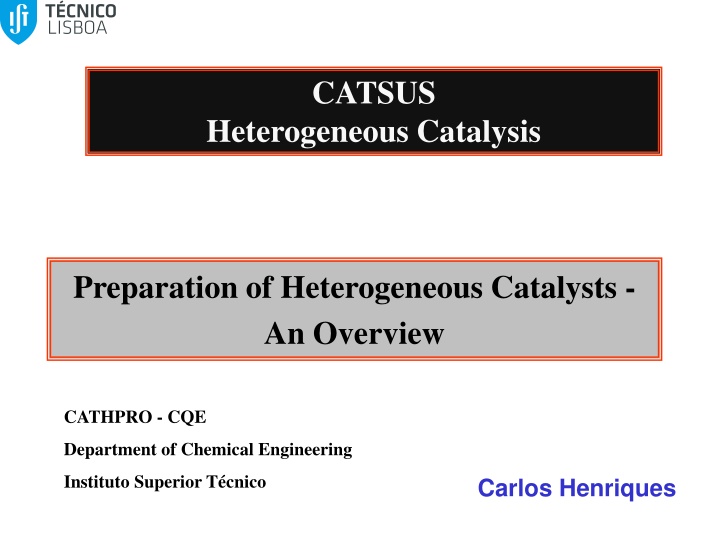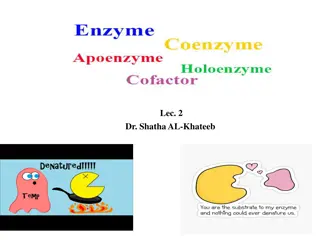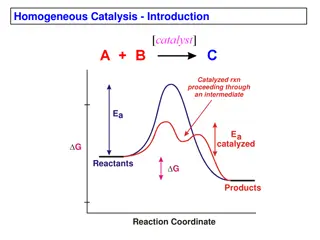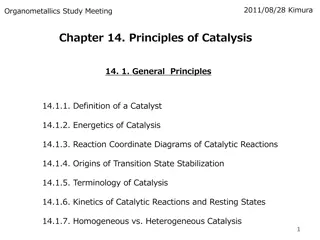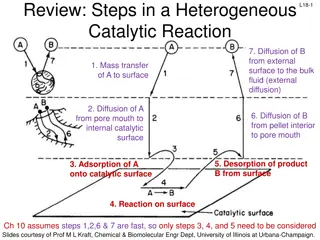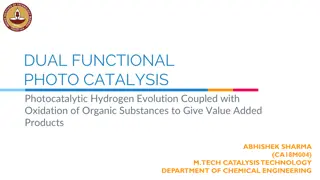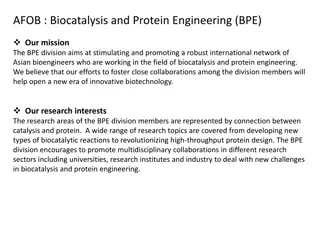Overview of Heterogeneous Catalysis and Catalyst Preparation
The development of catalytic processes involves research and development of new catalysts for better activity, selectivity, and stability. This study focuses on preparing new catalysts, determining their properties, and optimizing their development through structure-reactivity relationships. Catalysts can be classified as Supported or Bulk, based on their composition, with each group associated with specific reactions. Additional elements can be added to improve catalyst performance. Various metals, oxides, and active phases play crucial roles in catalytic functions for reactions like hydrogenation, dehydrogenation, oxidation, and more.
Download Presentation

Please find below an Image/Link to download the presentation.
The content on the website is provided AS IS for your information and personal use only. It may not be sold, licensed, or shared on other websites without obtaining consent from the author.If you encounter any issues during the download, it is possible that the publisher has removed the file from their server.
You are allowed to download the files provided on this website for personal or commercial use, subject to the condition that they are used lawfully. All files are the property of their respective owners.
The content on the website is provided AS IS for your information and personal use only. It may not be sold, licensed, or shared on other websites without obtaining consent from the author.
E N D
Presentation Transcript
CATSUS Heterogeneous Catalysis Preparation of Heterogeneous Catalysts - An Overview CATHPRO - CQE Department of Chemical Engineering Instituto Superior T cnico Carlos Henriques
The development of catalytic processes requires research and development of new catalysts more active and more selective, particularly with greater stability. This study consists essentially in the preparation of new catalysts, the determination of their catalytic and mechanical properties, the study of its chemical-physical characteristics and, finally, to establish structure-reactivity relationships allowing optimization. their development and A given chemical transformation process is usually catalyzed by a very small number of catalysts. A real catalyst, adapted to a given process, it is usually a complex composition solid. 2
It consists of an active phase to provide a maximum specific area, is deposited on a carrier/support, sometimes in very small amounts (like with precious metal) Supported Catalysts However, there is one type of catalysts, which are exclusively composed of one or more active phase (metal oxides, mixed oxides) Bulk Catalysts In order to systematize the properties of catalysts, these are usually classified into groups: Metals Semiconductors (oxides, sulfides ...) metal oxides with insulating character (alumina, silica- alumina, zeolites).
Each of these groups is usually associated with one type of reactions/one catalytic function Mono-functional It may therefore be necessary catalyst that has multiple functions simultaneously Bi- or Multi-functional Other elements or compounds are added to the catalyst (promoters, stabilisers, .) which aim to improve their performance (activity, selectivity, stability)
? Metals? Ni,? Co,? Fe? Pd,? Pt,? Rh,? Ru,? Ir? Cu,? Ag? Acids? Modified? Alumina? (Cl-,? F-)? Silica-Alumina? Zeolites? Oxides? ZnO,? CuO,? Cr2O3,? Fe2O3,? V2O5,? MoO3,? BiO3,? WO3? Oxidation? Hydrogenat ion? Dehydrogen ation? Cyclisation? Supported? ions? Ni2+,?Mo6+,? Cr3+,? Ti3+,? Zr4+,? Re7+? Sulfides? Ni2S2,? Co9S8,? MoS2,? WS2? Main? active? phases? Reactions? Hydrogenation? Dehydrogenation? Hydrogenolysis? Oxidation? Reduction? Cyclisation? Isomerisation? Etherification? Oligomerization? Alkylation? Cracking ? Esterification? Hydration? Paraffins? and? alkyl? -aromatics? isomerization? Production? of? ethers? FCC? MTBE/ETBE? ? Oligomerization? Polymerization? Oxychlorination? ? ? ? Hydrogenation? Hydrogenolysis? Main? industrial? applications? Synthesis? NH3? Oil? refining? Hydrogenation? Selective? oxidation? Deep? oxidation? SynGas? NOx? reduction? Selective? oxidation? MeOH? NOx/SOx? elimination? (plants)? ? Olefins? oligomerization? PE? PP? EDC? Hydrotreating? in? refining? Hydrocracking? ?
Catalysts must present: an appropriate activity, which will depend on its chemical and structural properties for a given operating conditions (flow rates, temperature, pressure) a high selectivity, which is of great importance, especially for reactions in which organic molecules are involved, and where several parallel and/or series reactions may occur. The selectivity to the desired product depends not only on the use of the more selective the catalyst, but also the chosen operating conditions (temperature, pressure, space velocity)
a mechanical strength that hinders the formation of fine abrasion of the catalyst particles, which would cause an increase in load miss the reactor a thermal resistance, as the catalyst should not, undergo phase changes (especially in the case of suffering high temperature ranges) and/or sintering (formation of larger particles by agglomeration of smaller particles, with a corresponding loss of specific area - area per unit mass) or what is commonly referred to a decrease in its activity and / or selectivity.
a stability that allows (especially for systems operating with fixed bed reactors) a relatively stable behaviour over the operating time performance. The variation in catalytic performance may be due either to the formation of side products ("coke", as in a large number of processes involving organic molecules), either reversible or irreversible heteroatoms (sulfur on supported metallic catalysts, bases on acid catalysts, vanadium/nickel on cracking catalysts) which act as "poison" for the catalyst although it may seem a minor factor, the cost of a catalyst can become prohibitive to industrial use (use of metal oxides instead of noble metals - Pt family, or increased metal dispersion in a supported catalyst). adsorption of
Methods of Catalysts Preparation Catalysts preparation methods determine, in addition to its composition, the degree of dispersion of the catalyst active agents, their porous structure and therefore their catalytic performance. In the case of catalysts prepared by precipitation, the type of pore structure and surface area depend on the experimental conditions: pH, concentration of solutions used, type of solvent, temperature, rate of precipitation, the precipitate aging, washing, drying and heat treatment (activation)
In the case of catalysts prepared by impregnation, the support transmits to the catalyst its morphology, its texture and its mechanical strength. In this case, the dispersion of the active phase on the support depends on factors such as the concentration of the solution, solvent type, temperature, agitation, drying and heat treatment. The mechanical strength of the catalysts prepared in the form of grains (pellets or cylinders), is obtained by choosing the appropriate method of mixing with a binder, and by optimizing the conditions of subsequent heat treatment (sintering of crystallites of "binder phase).
Types of catalysts considering the preparation method Bulk Catalysts - catalysts are normally formed by a single active phase (transition metal oxides, mixed oxides, sulfides) Supported Catalysts - catalysts in which the active phase is dispersed on an inert support (silica, activated alumina) or forming a second active phase (acidic aluminas, silica-aluminas, zeolites) - bifunctional catalysts (Pt /Alumina, Pd /HY ; Cu/ZSM-5)
Main operations on Catalysts Preparation A. Bulk Catalysts: Dissolution (starting compounds, very soluble in the chosen solvent: Ex. - Nitrate in aqueous solution) Precipitation (to obtain a solid phase from a liquid phase - conditions to be satisfied: thermodynamics (solubility product is reached); kinetics (the supersaturation state is reached): usually a hydroxide, by varying the pH. Precipitates can be crystalline or amorphous, and their formation takes place in two steps: (i) nucleation (formation of germs); (ii) growth of germs and / or aggregation of the particles.
Hydrothermal Treatments: may occur during various stages of catalyst preparation: (i) dissolution of part of the solid by the solvent; (ii) transfer of dissolved species and (iii) precipitation of a substance different from the initial, (iv) washing removal of nitrates, chlorides ; (v) drying; (vi) calcination (determines the proper functioning of the catalyst: pore diameter, particle size, surface area), (vii) final activation (usually in situ)
Calcination - usually takes place under air or nitrogen, at high temperatures. During calcination various changes can occur: (i) chemical reactions of decomposition of the precursors of the active agents with release of volatile species that form the porosity of the catalyst; (ii) modification of the crystal structure, phase change, change of crystal structure or stabilizing an amorphous crystalline structure; (iii) creation of porosity; iv) modification of the texture by sintering (particle agglomeration), modifying the specific surface area
B. Supported Catalysts: Preparation of the support ( normally a bulk species), as described for the bulk catalysts; Impregnation (introduction of the active phase on the support); filtration and drying (normally can determine location of active species in the support structure); calcination (starting compounds decomposition) reduction (formation of metal reduced species) From the point of view of catalysis, the support may be inactive (monofunctional catalyst) or active (bifunctional catalyst).
Case Study - Pt/Alumina catalyst (commercial alumina) 1- tetramine platinum nitrate aqueous solution impregnated in alumina 2- filtration and drying (120 C) 3 - calcination in air at 450 C (removal of nitrates ~ 350 oC and formation of the metal oxide, PtO) 4 metal oxide reduction under hydrogen at 500 C (Pt0/Alumina)
Used Supports - Materials that are able to disperse active agents, in order to increase their effectiveness or the mechanical strength of a catalyst: - Chemical neutrality (not only for the reactants and the reaction products, but also to the compounds used during the preparation) - Good mechanical properties (abrasion resistance, hardness) - Stability under reaction conditions and regeneration (water in feed at high T; "cracking" catalysts regeneration) - a high (adequate) specific area - adequate porosity (pore volume, average pore size and its distribution) a low cost Alumina; Silica; Silica-alumina; Zeolites; Titanium oxide; Cerium oxide; Clays; Activated carbons
